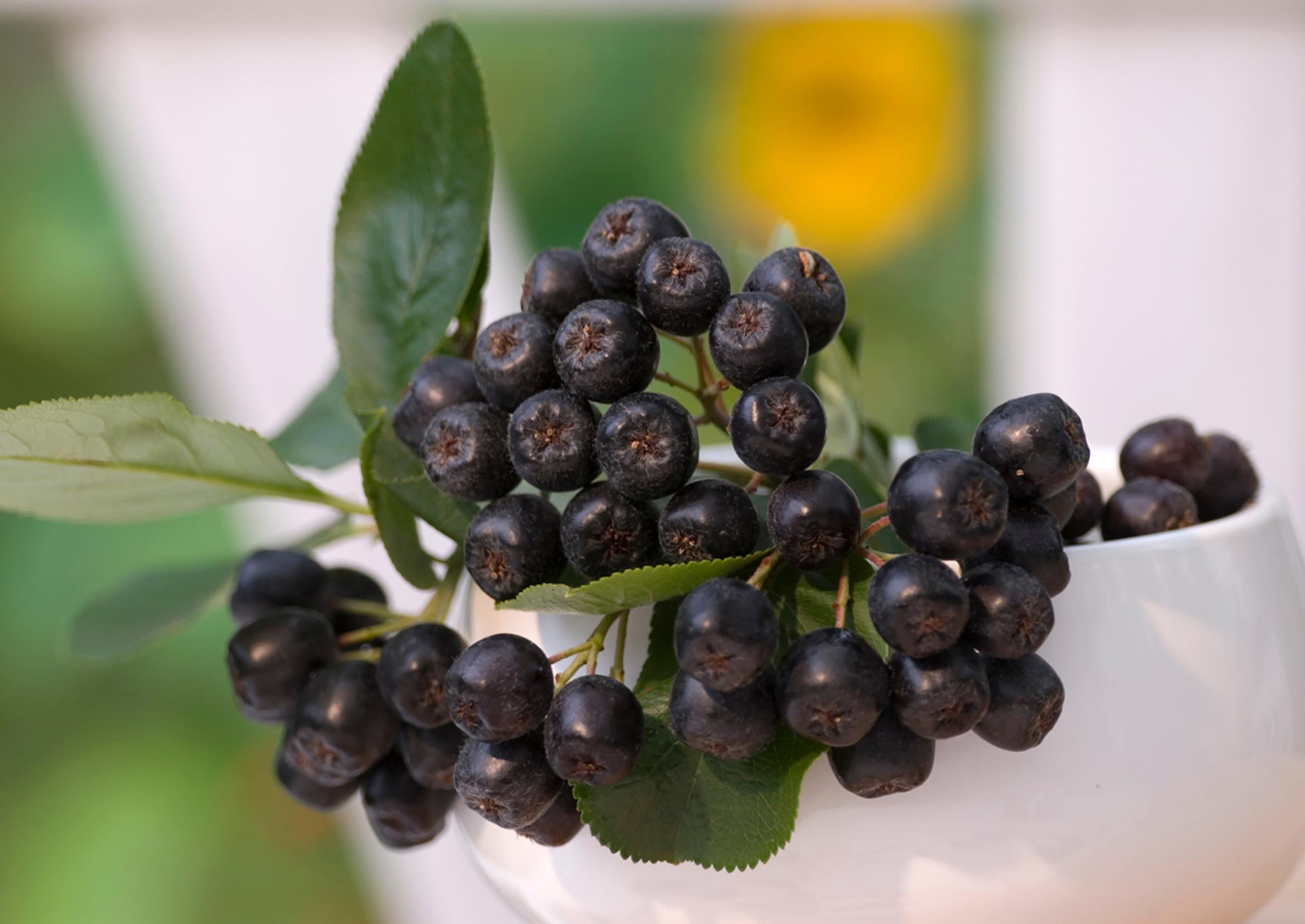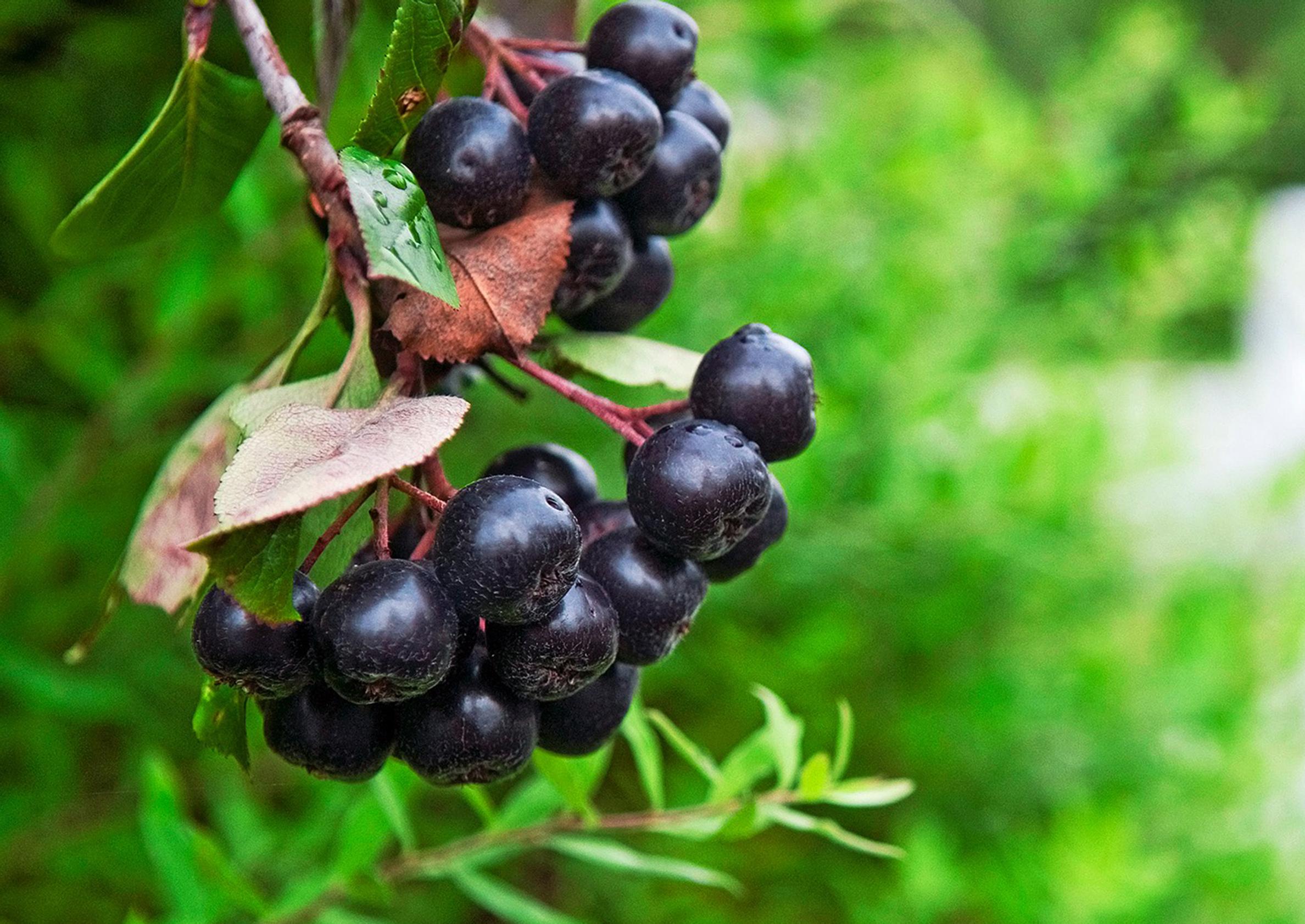
Chokeberry yields a generous harvest with minimal care—see our tips for growing aronia!
Chokeberry reliably provides a steady crop even when other berry plants disappoint. Also called aronia, it’s a hardy shrub that isn’t bothered by frost, disease, or pests.
Chokeberry (aronia) has such an abundance of good qualities that many other shrubs would be glad to have even half of them.
Chokeberry has been bred to produce large berries. It has a neat growth habit and may not need any care at all. It blooms around mid-June with abundant white flower clusters, and its glossy, dark leaves turn a brilliant red in fall. Chokeberry tolerates winters in southern Finland’s and thrives in sheltered spots as far north as central Finland.
On top of all that, chokeberry almost always yields a generous harvest, with clusters that are easy to pick. Chokeberries can be turned into juice, wine, jelly, or jam. Even though it’s a large shrub, it also suits smaller yards because it’s sold grafted onto a rowan trunk as a small ornamental tree.
Edible and ornamental berries
In Finland, red chokeberry (Aronia arbutifolia), black chokeberry (Aronia melanocarpa) and ornamental chokeberry (Aronia x prunifolia) are also used as ornamental shrubs. Ornamental chokeberry is a hybrid of red and black chokeberry.
The berries of ornamental chokeberry and black chokeberry can also be used in cooking. In favorable conditions ornamental chokeberry may even in growing zone VI.
All chokeberry species produce edible berries, though they taste bitter when eaten fresh. They’re great in jams and juices, especially with apples or other berries. Wine and liqueur makers value their striking color.
It’s hard to tell ornamental chokeberry apart from the edible chokeberry. Ornamental chokeberry’s berries measure about 5–7 mm across, while those of the edible chokeberry are about 10 mm. Ornamental chokeberry also has smaller leaves.
Chokeberry ‘Viking’
- Height: 1.5–3 m
- Bloom time: early June
- Berry: nearly black, fairly large
- Soil: fresh, nutrient-rich
- Site: sunny
- Pests: rabbits may eat the shoots
- Hardiness zone: I–IV(V).
Ornamental chokeberry
- Height: 1.5–3 m
- Bloom time: early June
- Berry: nearly black
- Soil: fresh, nutrient-rich
- Site: sunny to partially shaded
- Pests: rabbits may eat the shoots
- Hardiness zone: I–V.
How to grow chokeberry from seeds or cuttings
All chokeberry aronia species, including the hybrid ornamental chokeberry, can be propagated from seed. Sow seeds or dried berries in fall or early spring in boxes, then cover them with a couple of centimeters of sand. If there’s a chance of snow, move the boxes outdoors.
Seeds need a cold stratification period, which can be done in moist, cold storage. The stratification takes at least three months at a temperature of 0–5°C.
Once placed in a warm environment, they usually germinate in about a week. The seedlings are ready for planting a few years after sowing. Red and ornamental chokeberry can also be propagated from runners or root shoots.
If you’d like to try cuttings, take softwood or semi-hardwood cuttings by Midsummer. Remove the lowest leaves and place the cuttings in a peat-based seed starting mix. Cover them with a plastic bag to keep moisture in and to even out temperature fluctuations.
Chokeberry’s key requirement: light and space
Chokeberry and other aronia species adapt to different soils, as long as the soil is well aerated and retains enough moisture. In poor sandy soil, growth and blooming are meager. In heavy clay, shoots stay short—but the shrub may still flower profusely if it gets plenty of light.
For the best harvest, plant chokeberry in moist, nutrient-rich soil where it gets plenty of light. In shady locations, it may grow lushly but produce fewer blooms.
Excessively wet soil weakens chokeberry’s winter hardiness, while too much nitrogen fertilizer lowers yield. Slightly acidic soil is ideal, with a pH of about 5.5–6.5.
Chokeberry also needs ample root space, so avoid planting it near trees or other shrubs.
Chokeberry grows 1.5–3 meters tall. Leave about three meters between individual shrubs. For a hedge, 1–1.5 meters between seedlings is enough.
Ideally, the topsoil layer should be 50–70 centimeters thick.
Planting and pruning chokeberry aronia
Plant bare root chokeberry seedlings in fall or spring at the same depth they grew before. In spring, cut them back to 15–20 centimeters right after planting. For fall plantings, wait until the following spring to prune. Pruning encourages branching.
Container-grown seedlings can be planted any time during the growing season. If they have already started growing, do not prune. Container-grown chokeberry seedlings are typically older than bare-root seedlings and have enough shoots, so they usually don’t need pruning. A good seedling has at least three or four branches.
Later on, chokeberry doesn’t require regular pruning. Only remove damaged branches or extra root shoots. If the shrub becomes too dense or tall, you can rejuvenate it in early spring by cutting the entire plant to 20–50 centimeters. New shoots will appear on the stubs, and you’ll get a harvest in a couple of years.
Fertilizing chokeberry aronia
A light application of fertilizer in spring is enough for chokeberry. Use a low-nitrogen fertilizer intended for berry plants. After a heavy rejuvenation pruning, a general-purpose fertilizer is fine.
If the soil is fertile, chokeberry may not need any additional fertilizer, especially if fallen leaves are left to decompose at its base in autumn.
Chokeberries ripen in September
Chokeberry berries usually ripen around mid-September or later, and they can be picked in clusters or individually. A mature chokeberry shrub can produce about 7–8 kg of berries. Keep in mind that these berries can stain when you pick them.
5 good reasons to choose chokeberry for your yard
- Showy blooms
- Reliable, abundant berry harvest
- Vibrant red fall color every year
- No diseases or pests
- Extremely easy to care for

The wide array of chokeberry names
- Black chokeberry Aronia melanocarpa is the ancestral form of chokeberry. Russian plant breeder Ivan Mitchurin developed large-berried, productive varieties for industrial use in the early 1900s.
- One of these cultivars is called ‘Viking’. Cultivars ‘Elata’ and the Finnish ‘Karhumäki’ are also known for high yields.
- Don’t worry too much about chokeberry names. Both ornamental and edible forms descend from black chokeberry. ‘Viking’ always refers to a large-berried chokeberry.
- If ornamental chokeberry is sold as Aronia melanocarpa, you’ll find out by fall if it’s ornamental or genuine black chokeberry. Black chokeberry has yellow fall foliage, whereas ornamental chokeberry turns red.
Sources: Blomqvist, Leif, Trädgårdens bär, Leif Blomqvist. Koivunen, Taina and Saario, Meeri, Suomalainen piha ja puutarha, Gummerus. Suomalainen puutarha/Marjat ja hedelmät, Weilin & Göös. Alanko, Pentti and Saario, Meeri, Pihan ja puutarhan marjat, Tammi


